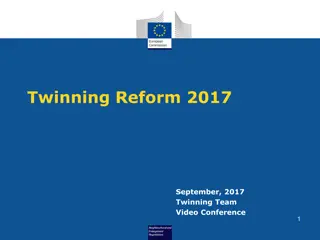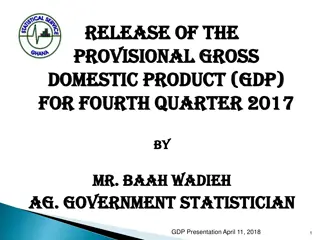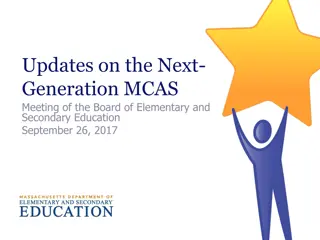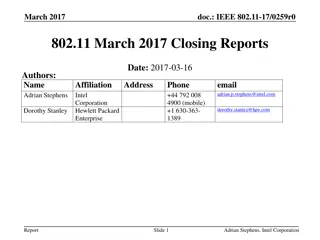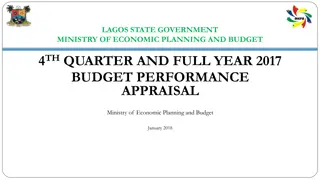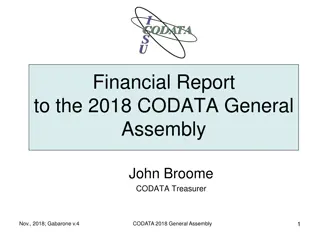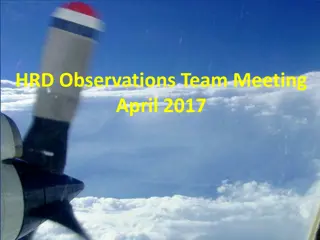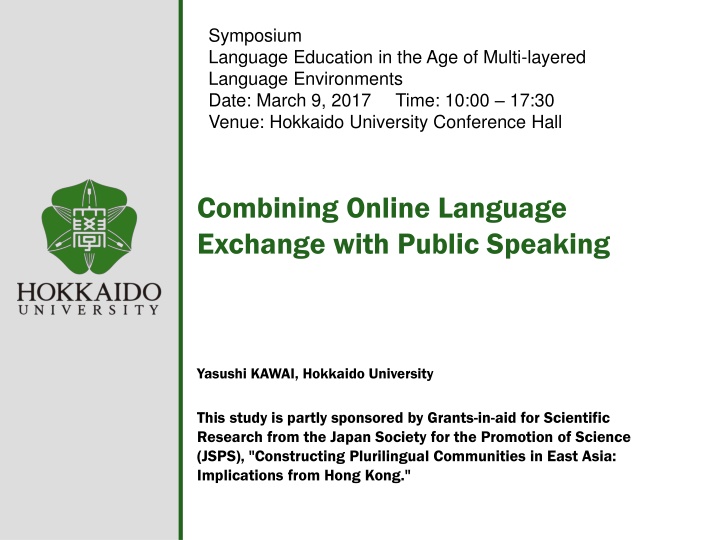
Symposium on Multi-layered Language Environments in Education
Explore the innovative combination of online language exchange and public speaking in education, focusing on Japanese, Hong Kong, and American students' communication. Discover the benefits of tandem learning, reciprocity, and autonomy in language acquisition. Join the discussion on constructing plurilingual communities and translanguaging in language education.
Download Presentation

Please find below an Image/Link to download the presentation.
The content on the website is provided AS IS for your information and personal use only. It may not be sold, licensed, or shared on other websites without obtaining consent from the author. If you encounter any issues during the download, it is possible that the publisher has removed the file from their server.
You are allowed to download the files provided on this website for personal or commercial use, subject to the condition that they are used lawfully. All files are the property of their respective owners.
The content on the website is provided AS IS for your information and personal use only. It may not be sold, licensed, or shared on other websites without obtaining consent from the author.
E N D
Presentation Transcript
Symposium Language Education in the Age of Multi-layered Language Environments Date: March 9, 2017 Time: 10:00 17:30 Venue: Hokkaido University Conference Hall Combining Online Language Exchange with Public Speaking Yasushi KAWAI, Hokkaido University This study is partly sponsored by Grants-in-aid for Scientific Research from the Japan Society for the Promotion of Science (JSPS), "Constructing Plurilingual Communities in East Asia: Implications from Hong Kong."
1 Purpose of Presentation This presentation aims to report on an online language exchange among students in Japan, Hong Kong, and the United States of America. Japanese learners of English and Chinese and American learners of Japanese communicated using both English and Japanese via email, text chats, and online video presentations. Data regarding second language anxiety, flow experience and speaking strategy use were collected from the Japanese students. These results will also be presented.
Online Language Exchange (Tele-tandem Learning) Learning in tandem can be defined as a form of open learning, whereby two people with different native languages work together in pairs in order to learn more about one another's character and culture, to help one another improve their language skills, and often also to exchange additional knowledge for example, about their professional life. (Brammerts & Little, 1996, p.13)
Three principles of tandem learning Separation of languages: Divide one meeting session into two phases; use one language in one phase. Reciprocity: Both participants have benefits by changing roles of learners and proficient others. Autonomy: Learners decide what and how they study by themselves. (Vassallo & Telles, 2006)
Translanguaging Online Presentation and Language Exchange (TOPLE) Fall semester in 2015-2016: Hokkaido University, University of Hong Kong, University of Massachusetts, Amherst. Spring semester in 2016: Hokkaido University, University of Hong Kong, Chinese University of Hong Kong, University of Massachusetts, Amherst. Fall semester in 2016-2017: Hokkaido University, University of Hong Kong, Chinese University of Hong Kong, Hong Kong Polytechnic University, University of Massachusetts, Amherst, Helsinki University, University of Alabama. 4
5 Translangaging Online Presentation and Language Exchange (TOPLE) Philosophies for TOPLE From Monolingual Society Native Speaker Model to Multi-layered Language Society Bilingual Model Translanguaging Second Language Speakers Wellbeing
6 Previous Model: Monolingual Society Native Speaker Model Goal: To acquire native speakers norm of language used in a monolingual society. Achieve the target proficiency level first, then use the language with native monolingual speakers in the target language society. Ideal L2-self (Dornyei, 2009) perfectionism; lack of sense of achievement (Lake, 2013) Ought-to L2-self (ibid) depression, anxiety, pessimism, psychological disorder (Lake, 2013)
7 New Model: Multi-layered Language Society Bilingual Model Increase: Move and immigration across borders; L2- communication among non-native speakers L2 speakers speak among native speakers L2 speakers speak with other L2 speakers. Language used in that communication is one language resource. (Garcia & Li, 2014) if ELI (English as International Language) belongs to its users, there is no reason why some speakers should provide standards for others. (McKay, 2002, p.126) L2 speakers use the language while it is incomplete; the L2 proficiency keep developing while they use it.
8 Translanguaging Languaging refers to the process of making meaning and shaping knowledge and experience through language. (Swain, 2006, p.98) Instead of producing and comprehending a message following an established language code, one will construct meaning together by using one s own language repertoire. (Swain, 2006) Attain the best communication by learning and adapting to each others language behavior. (Garcia & Li, 2014) Learn while using a language.
9 Second Language Speakers Wellbeing Positive Psychology: Seligman. Positive Psychology in SLA: MacIntyre, Gregersen, Mercer. Flow: Csikszentmihalyi What is happiness? Money, Social Status, Health, Winning in a competition Interview with expert professionals such as musicians. Sense of complete absorption in the activity=flow. Happiness = to be able to feel flow in his/her occupation. Well being for second language learners: Good learner studies (Rubin, Oxford, Griffith ) successful learners = highly proficient L2 speakers = Happiness .? SLA studies: Fossilization of L2 (Selinker, 1972), L2 anxiety (Horwitz, Horwitz, & Cope, 1986)
10 TOPLE activity: Email exchange 1. Self-introduction and introduction of hometowns. 2. Use only one language in a half of a mail. For example English for the first half, and Japanese for the second half. 3. Exchange emails at least one time. One can exchange as many times as they want if both agree. 4. Many participants exchanges more than twice because they needed to decide the date for text chat.
11 TOPLE activity: Text chat 1. Partners exchanged emails to decide the date for text chat. 2. They talked on text chat about one hour, 30 minutes in English, 30 minutes in Japanese. It could be extended if both agreed. 3. Choose at least one topic each from a list for English and Japanese. Example of topics: Subway systems; Boys, be ambitious; Minuteman; Octopus card; Soup curry; If you are the one; Hatsune Miku.
12 TOPLE activity: Online presentation 30 second presentations One English presentation and one Japanese presentation Self-introduction, hometown introduction, show and tell If one does not like to show his/her face, one can show only photographs or items and give explanations.
13 In-class presentations Japanese students reported their communication with overseas tandem partners in the form of short speeches in class. (1)Introduction of their partner(s). (2)What they learn about the partners, their places, their schools. (3)Question from class.
14 Measurement tools Speaking strategy scale was developed based on Kawai (2008). 20 items. Cronbach s =.911. Scale for second language anxiety: FLCAS (Horwitz, E. K., Horwitz, M. B., & Cope, J., 1986). 33 items. Cronbach s =.880. Scale for flow (Czimmermann, E. & Piniel, K., 2016; Egbert, 2003). 27 items. Cronbach s =.883. An original attitude scale was prepared for tandem learning. 5 items. Cronbach s =.822.
15 Speaking strategy items Pre-task strategies (13 items) Gather as much information as possible from books, the Internet and interview regarding the topic. Rehearse hypothetical interactions in advance with someone else. In-task strategies (5 items) Have a goal for the day before starting discussion such as asking at least one question. Post-task strategies (2 items) Look into dictionary about expressions that I was not able to say in the discussion.
16 Likely context of English use for EFL learners on practical level, they (speakers of English as an international English) may not need to acquire the full range of registers that is needed by monolingual speakers of English since their use of the language may be largely restricted to formal domains. (McKay, 2002, p.126)
17 Flow scale items Challenge-skill balance (5 items): This task was an exciting challenge for me, and I enjoyed that I could do what I had to do. Attention (4 items): When doing this task, I was completely absorbed in what I was doing. Interest (6 items): This task made me curious. Control (4 items): During this task I could make my own decisions about how to proceed. Boredom and apathy (8 items): I got bored during the task.
18 Items for attitude survey towards tandem learning 1. Tandem learning activities were useful for improving my English proficiency. 2. Tandem learning activities made me confident in speaking English. 3. Tandem learning activities were useful for reducing anxiety in speaking English. 4. Tandem learning made me feel study English harder. 5. While doing tandem learning activities, I was absorbed in the task and forgot time passing.
19 Spring semester in 2016 1. Did learners had second language anxiety in tandem learning? 2. Did learners had flow experience in tandem learning? 3. Can positive or negative expectation be reflected in the second language anxiety, flow, and post- semester feedback? 4. What reasons did learners express for their attitude towards tandem learning?
20 Spring semester in 2016 Second language anxiety (over 100 is considered being anxious) 32 out of 34 students replied. Mean 106.7 SD 17.2 Max 153 Min 78 Flow experience (over 81 is considered having flow) 16 students that accomplished text chats Mean 92.8 SD 8.8 Max 108 Min 78
21 Student feedback in spring semester, 2016 Pre-semester Do you feel anxiety about email exchanges and text chat with overseas students? Are you looking forward to exchanging emails and having text chats with overseas students? Do you want to avoid exchanging emails and having text chats with overseas students if it is allowed?
22 Three learners each for positive and negative expectation towards tandem learning activities: Anxiety scale, Flow, and post-semester feedback Pretest Email Text chat Anxious? Looking forward? Want to avoid? Anxious? Looking forward? Want to avoid? FLCAS A No Very much OK to do No Very much OK to do 78 B A little Very much OK to do A little Very much OK to do 87 C A little Much OK to do A little Much OK to do 98 D Very anxious Much If possible Very anxious Much If possible 125 E Very anxious No Absolutely Very anxious No Absolutely 130 F Very anxious Much Absolutely Very anxious Much If possible 153 Posttest Email Text chat Did you enjoy? Went well? Want to do again? Did you enjoy? Went well? Want to do again? FLOW A No No OK Very much Very well OK 99 B Very much Reasonably well OK Very much Reasonably well OK 102 C Much Reasonably well OK Very much Reasonably well OK 100 D Much Reasonably well OK Much Reasonably well OK 98 E Much Reasonably well OK Very much Reasonably well OK 100 F Much Reasonably well OK Much No OK 82
23 Attitude towards Tandem Learning in Opinion Essay Attitude Reason Can know different views Japanese are insensitive with racial discrimination Can develop language ability Can hear English spoken by native speakers Can develop language skills A For Small cost Success depends on partners too much Can make foreign friends B Against Students are too busy C For Can know foreign culture Can make foreign friends Can study English casually D For Can communicate with foreign students Good to have communication in Japanese as well Doing as extracurricular activities does not have enforcement Can develop writing ability in English E For Too little communication to feel effects F AgainstTime conflicts; Not time
24 Results Generally, second language anxiety is high, but they felt they had a good time. The degree of pre-task anxiety does not seem to predict flow experience. Evaluation on tandem learning depends on how the learner experienced the learning rather than what attitude they had in pre-task survey.
25 Fall semester 2016-2017 1. Does the use of speaking strategies reduce anxiety in language classes? 2. Do those who have pre-task anxiety use speaking strategies? 3. Do speaking strategy users believe tandem learning benefits them in raising their English proficiency?
26 Fall semester 2016-2017 Does the use of speaking strategies reduce anxiety in language classes? Anxiety Anxiety reduced reduced Anxiety Anxiety increased increased Total Total Strategy Strategy positive (60 or more) (60 or more) positive 5 5 10 Strategy Strategy negative negative (Under 60) (Under 60) 4 6 10 Total Total 9 11 20 2=0.202, df=1, n.s. Cramer s V=0.101
27 Fall semester 2016-2017 Do those who have pre-task anxiety use speaking strategies? Strategy Strategy positive positive (60 or more) (60 or more) Strategy Strategy negative negative (Under 60) (Under 60) Total Total Pre Pre- -task anxiety task anxiety high high (100 or more) (100 or more) Pre Pre- -task anxiety task anxiety low low (Under 100) (Under 100) 8 4 12 8 2 6 Total Total 10 10 20 2=3.333, df=1, n.s. Cramer s V=0.408
28 Fall semester 2016-2017 Do speaking strategy users believe tandem learning benefits them in raising their English proficiency? Tandem does Tandem does not work not work (Under 15) (Under 15) Tandem works Tandem works (15 or more) (15 or more) Total Total Strategy positive Strategy positive (60 or more) (60 or more) 8 2 10 Strategy negative Strategy negative (Under 60) (Under 60) 11 4 7 Total Total 12 9 21 2=4.073, df=1, p=0.044 Cramer s V=0.440 (But Mann-Whitney U test indicates p=0.056)
29 Results The use of speaking strategies did not indicate to reduce anxiety, but this seems to be because confident learners do not use strategies. Learners with pre-task anxiety have tendency to use speaking strategies though it was not indicated statistically significant. Strategy users tend to believe that tandem learning is beneficial for their language learning.
30 References Cheng, R. (2010). Computer-mediated scaffolding in L2 students' academic literacy development. CALICO Journal, 28(1), 74-98. Czimmermann, E. & Piniel, K. (2016). Advanced language learners experiences of flow in the Hungarian EFL classroom. Positive Psychology in SLA, 193-214. Egbert, J. (2003) The study of flow theory in the foreign language classroom Modern Language Journal, 87(4), 499-518. Garcia, O. & Li, W.(2014), Translanguaging: Language, bilingualism and education. London: Palgrave Macmillan. Horwirz, E. K., Horwitz, M. B., & Cope, J. (1986). Foreign language classroom anxiety, Modern Language Journal. 70 (2), 125-132. Kawai, Y. (2008). Speaking and good language learners, C. Griffiths (Ed.) Lessons from good language learners, pp.218-230. Cambridge University Press. Lam, W. S. E. (2004). Second language socialization in a bilingual chat room: Global and local considerations. Language Learning and Technology, 8(3), 44-65. Little, D., & Brammerts, H. (Ed.) (1996). A guide to language learning in tandem via the Internet. CLCS Occasional Paper No. 46., Trinity Coll., Dublin (Ireland). Centre for Language and Communication Studies. (ERIC Document Reproduction: ED 399 789) Marsh, D. (1994). Bilingual education & content and language integrated learning. International Association for Cross-cultural Communication, Language Teaching in the Member States of the European Union (Lingua), University of Sorbonne, Paris. McKay, S. L. (2002). Teaching English as an International Language. Oxford University Press. Oxford, R. L. (1990). Language learning strategies: What every teacher should know. New York, NY: Newbury House. Swain, M. (2006). Languaging, agency and collaboration in advanced second language proficiency In H. Byrnes (Ed.), Advanced Language Learning: The contribution of Halliday and Vygotsky (pp. 95-108). London: Continuum. Vassallo, M. L. & Telles, J. A. (2006). Foreign language learning in-tandem: Theoretical principles and research perspectives. The ESPecialist, 27 (1), 83-118. Yashima, T Noels, K. Shizuka, T Takeuchi, O Yamane, S Yoshizawa, K. (2009). The interplay of classroom anxiety, intrinsic motivation, and gender in the Japanese EFL context, Journal of Foreign Language Education and Research, 17, 41-64.
31 Thank you. Please send an email to the following if you would like a set of power point slides. kawai@imc.hokudai.ac.jp This symposium is sponsored in part by Grants-in-aid for Scientific Research from the Japan Society for the Promotion of Science (JSPS), "Constructing Plurilingual Communities in East Asia: Implications from Hong Kong."


